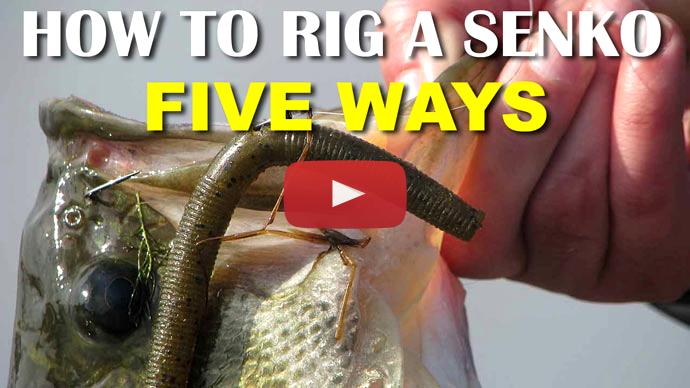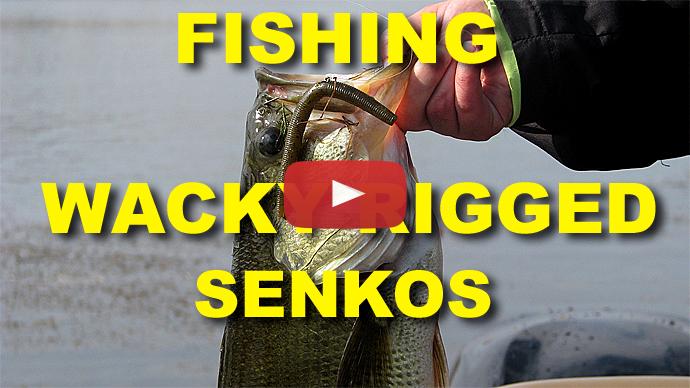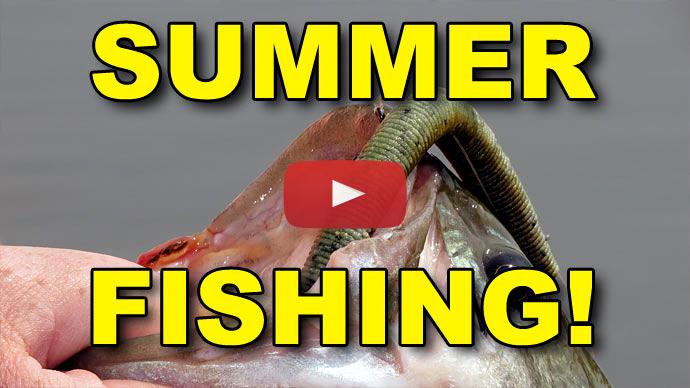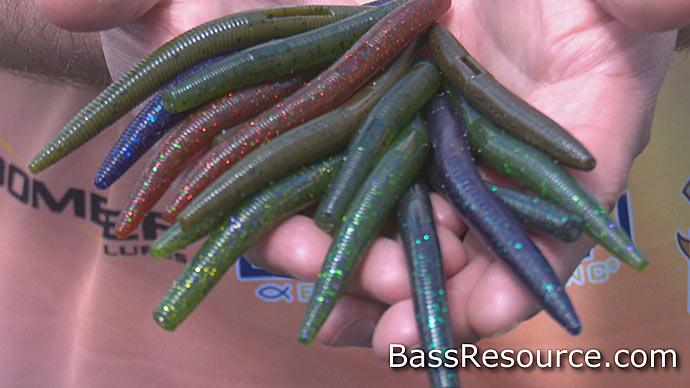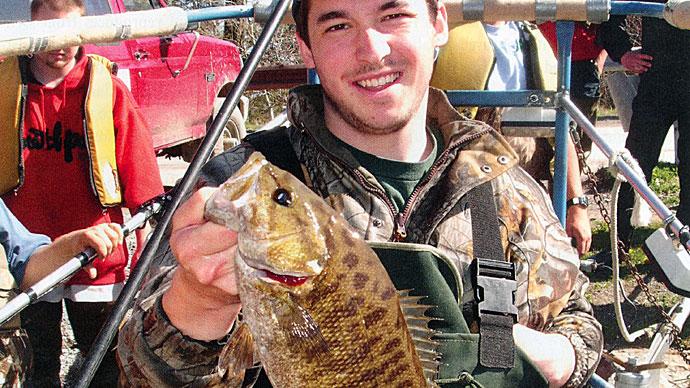Glenn: You gotta be kidding me.
Keri: Nice job. You may have to go get in. Get that one. Nicely done.
Glenn: Steer this guy through these bushes.
Keri: Get in the bushes. Get out of the bushes. Get in, get out, get in, get out. Glenn's got a big bass.
Glenn: Come here.
Keri: It ate the Slug-Go. It's in a tree. He's trying to get it out of a tree.
Glenn: Like that.
Keri: He's got it. He's got it. God, he can't walk. Look at that.
Glenn: Slug-Go. Look at that. Right there, guys. Slug-Go. That's a good fish. Here you go. Bye-bye guy.
Hey folks, Glenn May here with BassResource.com, and today I want to talk to you about a lure that doesn't get talked about very often at all, and that's right here. It's the Slug-Go. This little baby here has been around for a long time, and it catches fish.
I started fishing this, well, it became available about 1989, 1990, and I was fishing a tournament, and my fishing partner had these, and he out-fished me 14 to 1. He kicked my butt on it. And this was before they were really readily available. They had just come out in the market, and he had mail-ordered them. Yeah, we didn't have the internet back then. He mail-ordered them, and he won.
So, you know, I found out where he got them from, and a week later, I had several in my hand, and I've been fishing them ever since. So, what I'm about to tell you is decades of knowledge of fishing this bait. It really, the information I'm going to tell you here really isn't available on the Internet at least at the time that I made this video. So, if you see any information about it, check the date, and when that video was made, or when that article was made, they probably got it from this video, because you see it here first. So, let's get into it.
The Slug-Go here has, a lot of people will say, "Oh, it's the same as a YUM Dinger, right? Same thing." No, it's not. First of all, look how soft and flexible that YUM Dinger is compared to a Slug-Go. It's not the same. This is a lot stiffer plastic. Also, this is a different profile. You can see that has actually a baitfish kind of profile to it as opposed to just a soft plastic stick bait.
This has a different action in the water when it falls, it's got kind of that undulating, kind of wavering action as it falls through the water column, which is very enticing. A lot of fish bite it. This on the other hand, has pretty much no action at all when you put it in the water, it looks like a stupid piece of plastic just falling through the water column, and you're going to think, "Why would a fish bite a hunk of plastic like that?" Well, the beauty of it is the shape that it's in. It actually glides through the water. And I'm going to show you how to fish it.
You have to impart the action in it. That's the key difference. You have to impart the action versus this, you can just let it sink on its own wacky rigged, or any other, let the weight, do the job and you just wait for the fish to bite. Here, you got to work it a little bit.
So, let me get into how to fish this bait. We're going to put this away because we're not talking about a YUM Dinger anymore.
So, the key with this is how you rig it. There's a couple different ways to rig it, and there's different ways to fish it based on rigging it. But before I get into that, I want to tell you about the equipment that I'm using because that's key.
Here, I'm using a 7-foot, medium-heavy power, fast action rod. That is perfect for throwing, it's a baitcasting outfit if you notice. Now, a baitcasting outfit, why would you be using this? Because here's the thing, this bait is a lot lighter, a lot lighter than a YUM Dinger so it's harder to throw on a baitcasting rod. It's actually a little bit of a pain. You've got to have an educated thumb, and when you cast it instead of leaving, you know, little bit off the rod tip, you want 18 to 24 inches off the rod tip, and you want it...it's kind of a lob cast, real light, easy lob cast, and use the weight of the bait to cast out there. Don't try to throw it really hard because you're going to get a big ‘ol wad right here, and it's going to be a mess, and not going to be fun.
So, why do that instead of a spinning reel, right? Because a spinning reel, it's easier to throw lighter weights. Well, there's several reasons why. First of all, this bait with the way you're fishing it back to the boat is a lot of slack line and I don't have to tell you if you've been fishing spinning reels for a while. You get a little loop in the line with a spinning reel, and then the next thing you know, your next cast, and it's a big old bird's nest. There's a very high probability of getting that when you're fishing one of these with a spinning reel. Also, with a spinning reel, this bait dives, darts, it'll do a loop de loops, it can do another loop de loop. You can get a lot of line twist in it as a result. And that is the death in spinning reels. Line twist is terrible.
And also, just for me personally, but with spinning reels, if I'm fighting a fish, especially in cover, that's where this shines is in thicker cover, you've got to be able to work that bass through the cover, and back to you. And when you're fighting with a spinning reel, you can potentially pop that bail, and you know, release the line, and then you might lose the fish that way too. So, this is why I use baitcasting. I just have more control of the fish. It's a winch, and I can get them in the boat. So, that's what I use. You want to use spinning, knock yourself out. You've been warned.
Now, the line I'm using is a 15-pound copolymer line. Now, there's a specific reason for that. Braid, guys, braid is not the universal catch-all line. Braid is buoyant, has some buoyancy to it. It's gonna alter the characteristics, and the movements of this bait. You want this bait to do its own thing, you don't want the line to impede it. And with braid, how buoyant it is, it can actually impede the movement of this bait. Fluorocarbon, on the other hand, same thing, it's denser, it sinks. And so, it's also going to impede the action of this bait. So, this is why I use copolymer line. It's more of a neutral density line. It's better for fishing this kind of bait.
So, and its...falls very, very slow. This is the key thing what bass really like. This bait is great in water, anytime the water temperature is about 55 degrees but works especially well when the fish are really skittish, like when they first come up in the shallows in the springtime, or during the summertime when they're really finicky. Maybe you've had some fronts come through, and the fish are really reluctant to bite, this really shines. It has less action than other soft plastics stick baits, it falls real slowly through the water column, its movements are very subtle and enticing. It's great for catching a lot of fish. So, it all depends on how you rig it as to how you fish it.
Keri: There’s one.
Glenn: There you go.
Keri: It's a nice one too.
Glenn: Come here, you.
Keri: At least he thinks he's good.
Glenn: He's a good one.
Keri: He's got a big gut. He's fat.
Glenn: Get this hook out.
Keri: Slug-Go.
Glenn: Slug-Go. If can get it out to show you. I got him in there good. Get a pair of pliers. But there's a Slug-Go in there. Right there. Can you see that? It's a good fish. I got to use the pliers on this. There we go. Slug-Go. Now I can see it. Nice little belly on that guy.
Keri: He's been eating.
Glenn: He's been eating.
So, let me tell you a little bit about how I rig it. I'm going to go through this with you. I'm using the 2/0 regular wire, extra-wide gap hook. Not a heavy gauged hook, because you don't want to weight it down. Just a regular, normal, extra-wide gap hook is what you want to use.
Now, how I rig it. I'm going to get down close to you here. I'm gonna step down the livewell on my boat, I'm not on my knees or anything, just so you know, but here's the way most people rig it, kinda like a Texas Rig. So, you want to put it right in the nose, dead center, the hook. Right dead center in the nose. Straight down, right to where it bends. So, all the way down, just like that. Pull it straight on through. Now watch, I bring it down. You're going to see I buried the eye, and I flip it around. So, now, the eye is inside the plastic, just like that. Now, you want to see where it enters. See where that spot is, with a wire down here, where it enters the body, that's where you want the hook to go. So, I put it right in there, straight up and down, straight through, right through the middle. It comes up through the top, just like so. All right? You've got this rigged nice and straight. What I do sometimes is I'll skin hook it. I'll push the plastic up a little bit and bury the hook point back in just a little bit. That way it doesn't get hung up on anything. Perfect.
Okay. Now, that is the traditional way to rig it. And oh, one other thing. One really important thing. This is very important. So, you can almost see through this bait. I don't know if you can or not, but you can see the hook in there. I take 30 or 40-pound monofilament line, real wirey stuff, and I want to put it right through the eye of the hook that's buried inside this bait.
Now, the reason why I do that, this is the difference with this bait and other types. This bait has, the plastic in it is, for lack of a better word, brittle. And I just... see I cut that off. So, now the line, you can barely see it. It's not going to get hung up on anything, on any weeds or anything like that, but that pegs this hook or this bait, pegs this bait to the hook. Now, why do I do that?
Well, this plastic is, for lack of a better word, is brittle. And one of the reasons why people fell out of love with this bait is because it got to be known as a one fish wonder. You'd catch a fish on it and then, the plastic would split on it and break, and you know, you'd go through a lot of baits during the course of a day.
So, pegging it the way I just showed you, it enables that bait to stay in place, and it doesn't tear up as much. I can get three or four fish out of this, which is about the same you usually get out of a soft plastic stick bait these days, but only if you peg it the way I showed you. If you don't peg it, every time you catch a fish, it's gonna tear right up here on the top of the hook, and render it practically useless unless you cut off a little bit. So, do it that way. You make it last a lot longer. There's a tip for you.
So, the way to fish this bait is very simple. You cast it out there like I just showed you, I just told you about, real nice, easy lob. It lands real lightly on the water. Another plus, because it's such a light bait, it just softly lands on the water. And you use your reel handle to bring it back because it's so light.
This is originally dubbed as a soft plastic jerkbait. Because yeah, you can give it twitch with your rod tip, and you can fish it, because it's weedless, you can fish it in places where jerkbaits don't go because they have exposed hooks. So, you can throw it over weed beds, and over through lily pads. You can skip it under docks, that sort of thing. It's great and you don't have to worry about it getting hung up.
Problem is, you know, if you're down here, and if you twitch it with your rod tip, and you're jerking it, because this is so light, it's going to come flying right back at you really quick. A very, very subtle movement. If you throw this, you'll know what I mean, a slight movement and it'll go woo and it'll glide really far. Okay? So, just a quarter-turn of the reel. What you want to do is just take your reel hand, just kind of go, "Eh." That's it. Quarter-turn, maybe a half-turn, just a little, that's it. Little twitches. And that bait is going to dart, and glide, and come down, and it's going to dart this way, and I glide down. Real subtle, subtle movements. And that is what really entices the bass to bite. Just slowly working it through lily pads, stems, that sort of thing. Dropping it down to holes and weeds, working it through submerged bushes. Just slightly moves with the reel handle. That's all it takes. Great way to catch fish.
There we go. That's a decent one.
Keri: That's a nice sized fish. Put your poles down.
Glenn: There we go.
Keri: There he is.
Glenn: Come here, you.
Keri: It's a nice sized fish. Much better.
Glenn: Here we go. Right on the roof of the mouth.
Keri: Little buckaroo.
Glenn: Yeah.
Keri: For this lake though, that's probably a female.
Glenn: Slug-Go. Right there. That'll work. If I can get...
Keri: You got him good.
Glenn: Oh, I did. He wasn't going anywhere. It's part of keeping those hooks nice and sharp. All right, buddy. We'll let you go. Here you go. Goodbye.
Keri: He was gone.
Glenn: Now, a variance on that, and this is a different way to fish this, you got to rig it a little bit different. I'm going take the peg out of this that I just made. So, I'll just show you, I'm going to pull this little plastic peg out. See that little monofil I had in there.
So, here's another way to rig it. I showed you before you put the hook point right down the center, right where that line is. This is different now. What you want to do is put it a little bit underneath. So, instead of putting it right on the top, here, you want to put the hook underneath the chin like so. Bring it through, and then rig it just like I showed you before. Pull it all the way through. You get the eye all the way through, just like so. Bring it up, and then you just, just like you would a Texas Rig, bring it right on through, boom.
Now it's rigged. See this line? It's up underneath. And again, you want to peg it, just like...I'm not gonna do it right now because I showed you before, but peg it with that piece of monofilament.
Now what you've got is a little lip. Okay? Now, when you do the same action, the same movements, it's going to go up. Every time you give a little twitch, it's going to go up, and then fall back down. It's going to go to the side, kind of up, and glide back down, and it'll twirl around a little bit, and then come back down. It's really going to look like an injured baitfish trying to move around the water column. This is the number one way I rig it and catch most fish with it because it really does look like an injured baitfish. Just those slight twitches with the reel handle, and it just does that little diving, darting action. Perfect way to fish it.
Now, one other way is the opposite. And that is you want to put the hook through the top. Okay? So, just like I told you before, but now you're going to put the...you can put it up here towards the top, thread it on through, just like so. Bring it all the way through, and it's the same sort of concept again, you know, same Texas Rig type deal. Bring it right on through. Boom. Nice and straight again. That's what you want but now see the line is up at the top and you got this little lip right here. It's like a little crankbait bill. Okay?
So, now, again, you want to peg it just like I told you before, but now whenever you fish it, every time you twitch it, it's going to want to dive down. So, you're bringing along, it's going to dive down, and then you're got to pull up a little bit more, maybe reel up a little bit line, it's going to come up, and it's going to dive back down, and go this way, and come up a little bit more, and dive back down. If you ever seen an injured baitfish, you can see they kind of float up to the surface and they trying to dive down. That's kind of what this looks like when you do that. Doesn't float, but it does look like an injured baitfish that's struggling with its equilibrium. Another great way to elicit bites.
So, those are the three different ways I rig it with a hook. If you're fishing for deeper fish, deeper structure, you can throw this on a split shot rig. Just put your weight about 18 inches above the line here, 12 to 18 inches, or even a Carolina Rig.
The Carolina Rig, I'd use a little bit different outfit. I'd use a stronger baitcasting outfit with braided line, and then I'd use, again, that 15-pound line as a leader. But, and I would rig it with the hook underneath because every time you pull it on the bottom, you want to come up off the bottom, and then kind of float back down to the bottom. So, give it a little twitch, it'll come up, dive a little bit sideways, and come back down. Deadly, deadly way, of fishing this bait is a killer, and it's one that people don't use very often.
One of the things about this bait is I wouldn't recommend wacky rigging it because like I said, the plastic is kind of a brittle plastic, I promise you, wacky rigging it is going to be the best way for it to be a one-fish wonder. It'll split every single time you catch a fish. Plus, it doesn't have that action that you would get out of a YUM Dinger. It really isn't a very effective bait, wacky rigged. So, don't do that.
Now, like I said, this bait was originally marketed as a soft plastic jerkbait, but another way that it works really well is as a walking bait. You can actually walk the dog with this bait like you would a Zara Spook with the added benefit that it's weedless. So, this works really well over submerged vegetation, or emergent vegetation, and through lily pads. Even skipping it under docks, and then you can walk the dog back underneath the dock. That is a great way to catch fish with this bait.
Keri: Ooh. There you go.
Glenn: All right.
Keri: Nice fish.
Glenn: Just you and me, fish. Come on. Come on. It's just you and me. Let's go.
Keri: Nice fish.
Glenn: There we go. Get that hook out. That'll do. All right. Let's let you go. There you go. Bye-bye. All right.
Another way you can alter the action of this bait is to use nail weights. You can put a little nail weight on the tail, put that in there and it will go backwards. It'll work almost kind of like a Neko Rig. It works great when you want to get it underneath floating docks. You can cast up to it and that way it's gonna make it tail down, and go back down under the docks. You can take the nail weight and put it right down the middle. And that's going to cause it to sink horizontally at a faster rate than if you fished it weightless. Or you can take the weight and you can put it in the head and it'll go nose down, it'll look like a baitfish that's feeding on the bottom, which is a great way for example, if fish are on the bed, it looks like a little baitfish that's trying to feed on the bed, or just an innocent little unknowing baitfish that's feeding off the bottom somehow and it's easy prey.
As far as colors, it comes in all kinds of colors. Personally, I like this one. It's alewife. And then, I like the golden shiner here. Those are the two I've been using for several decades and they've been very productive for me. And I also like...I've got a trout color here, that I got on my deck, it's already tore up a little bit because I've caught a few fish with them. But the trout color is a really good bait color. They come in like 30 different colors, so, you know, pick the color that you like the most, go out there, and then fish it the way I just told you how to do it, and have yourself a whole lot of fun.
Again, you saw it here first on BassResource.com. If you want to see more information like this, just visit BassResource.com. Thanks for watching.

